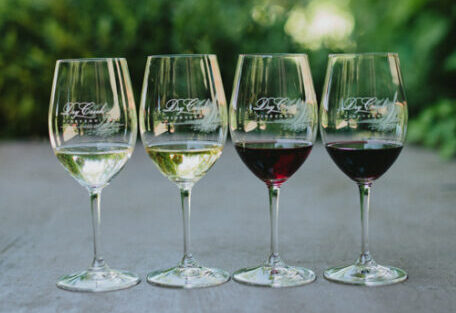White Wines
At a fundamental level, a white wine is white because the skins of the grape have been removed during the processing phase of winemaking. Taking this a step further, a white wine can be darker or lighter depending on whether or not it has been aged in oak barrels or stainless steel tanks. Also, the varietal itself can naturally be lighter or darker – for example, Chenin Blanc is almost always lighter in color than, say, Chardonnay.
Red Wines
With red wines, the skins have been left on, which is where the wine gets its color. As with white wines, the varietal itself can naturally be lighter or darker – for example, Pinot Noir is usually lighter in color than a Cabernet Sauvignon. All of this aside, one of the most important aspects of a wine’s color is the first impression it leaves after being poured into the glass.
A lot of information can be gleaned in the moments after the wine hits the glass. Is the wine white or red? Light in color or dark in color? Often times, this first impression can set the stage for the rest of the tasting experience. As a general rule, a well made wine should appear clear and bright. Haziness, bubbles (unless it’s Champagne), or a dull color can indicate something is off about the wine.
Another aspect to consider regarding color is viticulture techniques. Yield reduction, the process of reducing the number of grape clusters on a vine, can produce grapes of greater concentration, flavor intensity and deeper color.
In order to clearly see any color “flaws” with the wine, hold the wine glass at a slight angle against a white background, such as a sheet of computer paper. If possible, try to be in a well lit room that is relatively odor free (see the Smell section for more information). In general, white wines can go from a light straw color to a deep golden hue. Red wines that have a purple, dark hue tend to be younger wines. As red wines age they began to turn more ruby in color, with some orange and sometimes even brownish hues toward the edge of the wine:
White Wines
| This Color… | …Usually Reflects This Characteristic |
|---|---|
| Green-tinged | Youth |
| Straw | Majority of dry whites |
| Gold | Sweeter, more luscious whites |
| Light-brown | Wine may be in an “off” condition |
| Brown/amber | Too old (excess oxidation) |
Red Wines
| This Color… | …Usually Reflects This Characteristic |
|---|---|
| Purple | Youth |
| Ruby red | Some aging |
| Red | Several years of aging |
| Red-brown | Maturity |
| Mahogany | Considerable age (or improperly stored young wine) |


